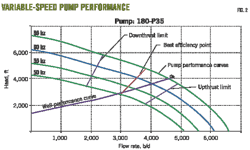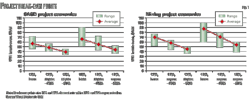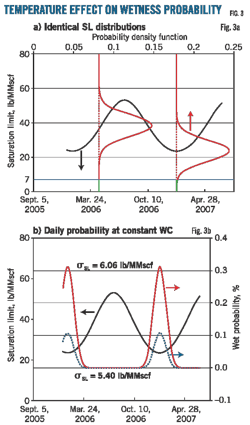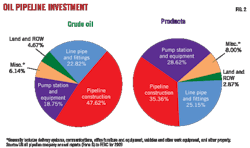Yunhu Lu
Mian Chen
Yan Jin
Yawei Li
Kai Fan
University of Petroleum
Beijing
Xueqing Teng
Ning Li
Tarim Oilfield Co.
Korla, China
K.P. Chen
Arizona State University
Tempe, Ariz.
The Yingmaili gas-condensate field in the Tarim area of western China required various technologies to drill horizontal wells through a thick salt-gypsum bed.
In the field, a Lower Tertiary sandstone formation contains the hydrocarbons that are trapped by an interbedded salt-gypsum-mudstone with an average 217-m thickness at a 4,700 m depth.
To improve the production rate, well completions in the field require the drilling of horizontal laterals through the salt-gypsum mudstone.
Complicating factors
The vertical distance between the salt layer and the reservoir is small, with a minimum distance of only 25.9 m.
After completion of the formations above the mixed salt-gypsum layer, the first attempt to drill a small-curvature horizontal lateral through the mixed salt-gypsum layer failed and the running of a 51⁄2-in. completion string was not possible in the intended interval.
To facilitate the development of this gas field, borehole trajectories must kick off in a salt-gypsum bed and the rig must run the 95⁄8-in. by 103⁄4-in. combined intermediate casing in a 121⁄4-in. curved borehole to seal the salt-gypsum bed.
Complex downhole conditions, however, proved to be major obstacles to the successful angle buildup of the trajectory. These conditions include:
• The 121⁄4-in. borehole restricts the deflecting ability of the bent sub, resulting in low buildup rates and making it difficult to control the well trajectory in the deviated section.
• The rock salt has strong creep characteristics. Weak strata exist between and under the salt layer. If the drilling mud weight is not controlled properly, it may lead to borehole shrinkage or drill pipe sticking in the salt-gypsum bed, influxes, and lost circulation. The section has a high drilling risk and requires a complex casing design.
• Because of salt creep and the curved borehole, the casing in the salt-gypsum bed is susceptible to external pressure that increases the risk of casing damage. The high-angle deviated well requires thick wall, high-strength casing, and successful running of the casing is difficult. The first attempt to drill a horizontal well (YM7-H1) in the salt-gypsum bed was in 2001. The attempt to get a stable borehole failed because of the difficulty in building angle in the mixed salt layer, and the serious salt creep that collapsed the 7-in. casing.
• The drilling requires a high-density barite drilling mud to ensure that downhole orienting tools function normally. This causes another problem because it is difficult to control the mud rheology and lubricity, which threatens safe drilling operation.
Technology breakthroughs
Successful drilling required several technology breakthroughs. These were based on the deep salt layer drilling technology and the ultradeep horizontal well drilling practice used in Tarim oil field.
Together with drilling engineers of Tarim oil field, we changed the casing program design for the horizontal laterals in salt layers, implemented safe drilling practices for drilling the curved borehole in salt layers, developed an optimal method for running casing; and designed a high-density, low magnetic, and low-erosion drilling mud.
These technologies succeeded in drilling the Yingmaili and Kela 2 gas wells through the salt-gypsum bed and proved the validity of the previous mentioned practices.
Wellbore configuration design
On the basis of three pressure profiles that affect the creep of the salt layers (Figs. 1 and 2), geological stratification, wellbore trajectory, and the oil and gas production requirements, we determined the guidelines for configuring the wellbore designs. In the Yingmaili block, intermediate casing must separate the Lower Tertiary sandstone reservoir and the salt layer; in Kela block, intermediate casing must separate the mixed salt bed at the top of GelieMu group.
The wellbore configuration of the horizontal wells in the Yingmaili block is (Fig. 3a):
• 133⁄8 in. at 1,500 m.
• 103⁄4 in. and 95⁄8 in. at 4,760 m.
• 7 in. at 5,258 m.
• 51⁄2 in. at 5,258 m (Fig. 3).
In the Kela block the configuration is (Fig. 3b):
• 133⁄8 in. at 150 m.
• 97⁄8 in. and 95⁄8 in. at 3,347 m.
• 7 in. at 3,773 m.
• 5 in. at 3,895 m.
Wellbore stability
Based on the geomechanics characteristics of the salt-gypsum bed, we established the creep deformation model of the curved borehole. We further analyzed the borehole instability risks of different borehole deviation angles and azimuths and determined the relationship between borehole shrinkage in the curved borehole of the salt-gypsum bed and deviation angles and azimuths.
When the angle between the kickoff azimuth and the direction of maximum formation stress is less than a certain degree, the hole shrinkage will increase with the increase of the deviation angle (Fig. 4a).
When this angle is more than a certain degree, the hole shrinkage will decrease with the increase deviation angle (Fig. 4b).
In the Kela-2 block, this critical angle is 42°, while in Yingmaili block the critical angle is 38°. With this result, one can predict the minimum allowable drilling mud weight in the salt-gypsum bed and develop procedures for meeting drilling safety standards.
Casing strength design
Our analysis determined that the external force on the casing changes with the deviation and azimuth angles in the curved borehole of the salt-gypsum bed. The nonuniform external squeezing force has a huge influence on the collapse strength of casing. The larger the nonuniformity factor is, the weaker the resistance strength to the external squeezing force (Fig. 5).
We also established the formula for the collapsing strength of the casing in the curved borehole of salt layers, checked the strength of the casing design, and analyzed the reasons of casing damage in the salt bed of well YM7-H1 (Table 1).
From this analysis, we recommended the use of VM140HC type heavy casing with a diameter 103⁄4 in. to meet the requirements (Table 2).
Wellbore profile design
After considering the actual deflecting ability of the bending subs, tripping resistance of casing, safe casing design, well trajectory control, geological risks, and other factors, we designed the pilot wellbore with a straight-increase-increase-straight profile with part of the horizontal section profile as straight-increase-increase-flat (Fig. 6a).
The analysis determined that the maximum deflection rates of the two wells should be less than 25°/100 m and the maximum drilling trajectory should not exceed 50°/100 m.
The actual well profiles were consistent with this design.
Running heavy casing
Our analysis predicted the casing trip friction and calculated the maximum friction coefficient of different bottomhole assemblies (BHAs) and casing in the curved hole. We also analyzed the influence of the curved hole and annulus on the casing trip friction. Based on these analyses, several engineering measures were made to ensure successful casing running.
These measures include raising the rigidity of the wiper trip drillstring greater than that of the casing by using a BHA that consists of one centralizer, two centralizers, four drill collar, and three centralizers (Fig. 7).
The successful implementation of these techniques ensured the safe running in of the 103⁄4-in. VM140HC casings with a 1-in. wall thickness.
High-density drilling mud
Conventional high-density drilling mud contains hematite that tends to corrode the wellbore and causes a serious magnetic disturbance. Directional deflecting tools and instruments cannot perform well under these conditions.
For our mud, we chose to control the rheology by:
• Using barite to weight the mud.
• Enhancing the inhibitive properties of the mud.
• Strictly controlling the content of the bentonite.
• Decreasing the types of the treating-agents used.
• Optimizing the weighting material and grain size composition.
• Enhancing solids control.
The mud selected was a potassium chloride sulfonated polymer-oil mixture salt drilling mud system with barite. Table 3 lists the mud properties.
Horizontal wells benefits
The successful drilling through the salt-gypsum with horizontal laterals improved the production performance over vertical wells in the YiMai 7 block. The wells allowed high production rates from the condensate gas reservoir in the Yingmaili block and delayed the water coning.
The wells increased the recovery from the gas field. By yearend 2009, the three salt horizontal wells have produced 110,000 tons.
The design of these horizontal wells shortened the drilling time and decreased drilling cost. The three wells in the Yingmaili block saved 50.33 days from the original well YM7-H1, and reduced the drilling cost by 14.9 million yuan.
The successful application of this technology set a series of new drilling records under complex geological conditions. As an example, the YM7-H2 well had a successful run of 95⁄8 and 103⁄4 in. combined casing into the 121⁄4 in. wellbore, and well YM7-H4 has a successful run of heavy casing down to a 4,767.94-m measured depth, or a 4, 684.87-m vertical depth, and a 72° deviation.
Although, we drilled successful horizontal wells in the salt-gypsum bed of Tarim oil field, some challenges remain:
• The gas reservoir formation under salt is deep (more than 6,000 m), with poor drillability, low penetration rate, and hard-to-control well trajectory.
• The bent sub is restricted in its deflecting ability in the ultradeep formation and the deflection rate is low.
• Creep of the salt-gypsum strata is serious, and there are weak strata between and under the salt layer. If the drilling mud weight is not controlled properly, it may lead to hole shrinkage or pipe sticking in the salt-gypsum bed, influx, and circulation loss.
• The high 1,500° C., high-pressure (the bottomhole mud column pressure as high as 150 MPa) downhole environment requires high-density drilling mud. If hematite additive is in the mud, it will affect the drilling tools and equipment. Using barite makes controlling the mud rheology difficult.
• The high temperature and high-pressure reservoir is vulnerable to washouts. The orientation tools now used for a directional well require pressure lower than 105 MPa and temperature lower than 1,250° C.
Acknowledgments
This research was sponsored by the CNPC Tarim Oilfield Co. the Program for New Century Excellent Talents at the China University of Petroleum, the Ministry of Education of China, 973 Program (2010 CBN226700).
References
1. Chen, S.C., Wang, S.C., and Zhang, J.C., "Horizontal well drilling techniques in subsalt oil zones," Oil Drilling & Production Technology, Vol. 30, 2008, No. 3, pp. 7-10, (in Chinese).
2. Li, N., Huang, G.L., "Horizontal well drilling techniques in Yingmaili 7 area," Oil Drilling & Production Technology, Vol. 32, 2009, No. 2, pp. 14-16, (in Chinese).
3. Han, Z.Y., Design and calculation of directional wells, Beijing: Petroleum Industry Press, 1989, (in Chinese).
The authors
Yunhu Lu ([email protected]) is a PhD student in drilling engineering at China University of Petroleum, Beijing. His current research interests are gas drilling, drilling techniques in gypsum beds, and directional drilling techniques under complex geology. Lu has BS in petroleum engineering from Yangtze University. He is a member of the Chinese Society of Rock Mechanics and Engineering and a member of SPE.
Mian Chen ([email protected]) is a professor and the dean of the College of Petroleum Engineering of China University of Petroleum-Beijing. His research interests focus on rock mechanics and drilling engineering. Chen has BS from Peking University, MS from Liaoning University, and PhD from China University of Mining & Technology. He is a member of the International Society for Rock Mechanics and chairs the Chinese Society of Rock Mechanics and Engineering, as well as Chinese Society of Rock Mechanics at Great Depth.
Xueqing Teng ([email protected]) is a senior engineer in Tarim oil field, and he is also the president of Tarim Oil and Gas Research Institute. His current research interests are drilling engineering management and research. Teng holds an MS degree in drilling engineering from China University of Petroleum, Beijing.
Yan Jin ([email protected]) is a professor in the College of Petroleum Engineering of China University of Petroleum-Beijing. His current research interests are in the areas of rock mechanics and drilling engineering. Jin received all of his degrees from China University of Petroleum (East China, and Beijing), in drilling engineering (BS, MS), and oil and gas well engineering (PhD). He is a member of International Society for Rock Mechanics, Chinese Society of Rock Mechanics and Engineering, and Chinese Society of Rock Mechanics at Great Depth.
Kang Ping Chen ([email protected]) is an associate professor in the School for Engineering of Matter, Transport, and Energy at Arizona State University and a visiting professor at China University of Petroleum-Beijing. His research interests are in non-Newtonian fluid mechanics, multiphase flows, and flow in porous media. Chen has a BS from Peking University and a PhD from the University of Minnesota. Chen is a member of ASME
Ning Li ([email protected]) is a senior engineer in Tarim oil field, and currently is working in Tarim Oil and Gas Research Institute. His current research interests are drilling engineering management and research. Li holds a BS in petroleum engineering from China University of Petroleum, East China.
Ya Wei Li ([email protected]) is a graduate student seeking a PhD in petroleum engineering at Texas A&M University. His research interests are in the area of petroleum rock mechanics. Li has a BS in mechanical engineering and an MS in petroleum engineering from China University of Petroleum-Beijing. He is a student member of SPE.
Kai Fan ([email protected]) is a graduate student seeking an MS degree at China University of Petroleum, Beijing. His current research interests are directional drilling and its applications, rock mechanisms. Fan has a BS in petroleum engineering from China University of Petroleum, East China. He is a student member of SPE.
More Oil & Gas Journal Current Issue Articles
More Oil & Gas Journal Archives Issue Articles
View Oil and Gas Articles on PennEnergy.com










